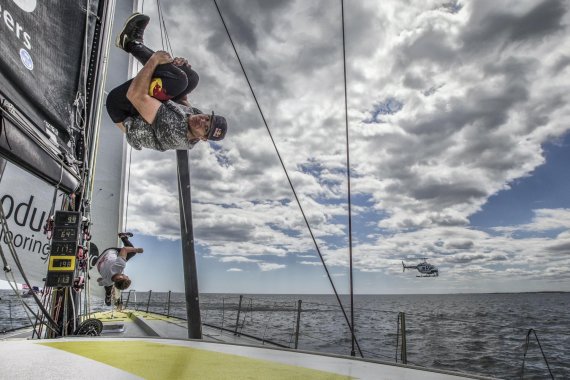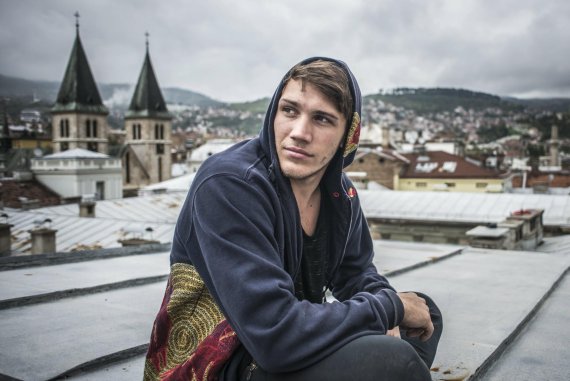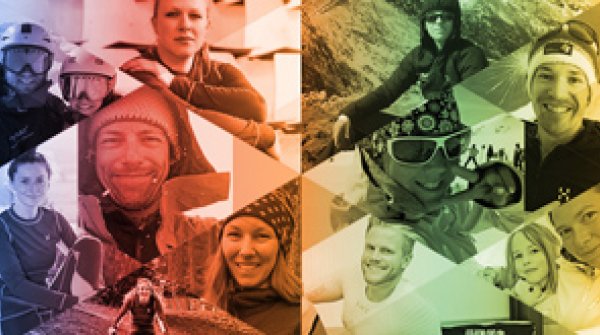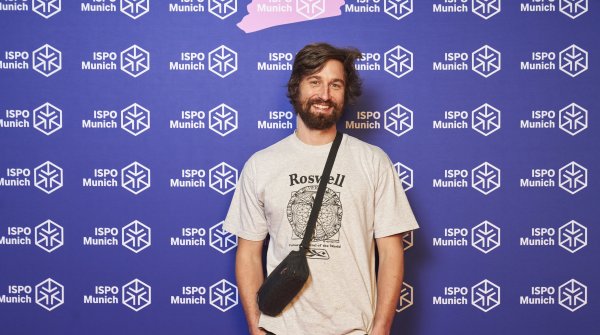
Your name doesn’t sound very German. Is Jason Paul somewhat of a stage name?
That’s really my name. My father’s a Brit, my mother’s German. I was born in Frankfurt and grew up bilingual.
Do you still live in Frankfurt?
I lived in Frankfurt for 21 years, but was on the road a lot. At some point a place of my own wasn’t worth it anymore.
No permanent residence?
I got rid of everything that doesn’t fit in my suitcase and travel from one project to the next.
Were you an athletic child?
I climbed on buildings, was on the move a lot, but was just average in every type of sport. I couldn’t do a handstand and could manage two pullups, max.
Today you’re one of the best freerunners in the world. When did you discover the sport?
I was always outside as a kid. Soccer was never my thing, I wanted to shoot the ball onto the roof more than into the goal. After a certain age, it was considered childish to climb on buildings or over obstacles. When I was 10 I escaped into the world of video games and amused myself with Prince of Persia, Spiderman, or Batman.
Whereby you stayed true to your basic need – climbing and jumping – in the virtual world.
Quite true. I sat and relaxed in front of the computer for five hours daily.
When did the transition come?
When I was 14 I randomly saw a video of a couple of young men from Paris who dove from roof to roof. It was love at first sight. I saw the movements and knew: That’s it!
Freerunning and social media star
Things went from the virtual world straight to the streets of Frankfurt?
There was nobody in Frankfurt who could have shown us anything. My best buddy and I taught ourselves everything. Freerunning was unknown. In the beginning we climbed and jumped over a lot of walls, totally banal.
That was exciting?
Very much so. We experienced Frankfurt anew, were constantly searching for any kinds of ledges and edges. We started awkwardly, but were very motivated and were always getting better.
The first summersault?
(laughs) That we practiced for the first time, very eagerly, in the pool or at night on the high jump mat at the track facility.
Is there a difference between parkour and freerunning?
Parkour is the source of the movement, originated in Paris, comes from the military and follows more of a martial art way of thinking. How do I move if I’m being hunted? How do I best jump out of a burning house? It’s about moving as efficiently as possible in an emergency situation. Freestyle elements appeared on the scene later. Freerunning is much more creative and fun.
Your video have gotten millions of views. The web is your stage. Do you also make appearances at competitions?
I used to participated very successfully at contests like “Art of Motion” and the annual world championships, which is why sponsors began to pay attention to me. Since then, though, photo and film productions are more fun for me.
Because you yourself were once under the spell of a video?
If I can get young people excited about sports, it does much more for me than winning a contest. I’m at home in the social media world. Classic media takes less notice of me and has a significantly lower coverage. Without Facebook, Instagram, YouTube or the Red Bull channel, my life would look very different today.
Freerunning is art in the urban habitat
Do you follow other types of sports online?
I get a lot of inspiration from climbing, breakdancing, and capoeira. Of course, I also like to watch Danny MacAskill’s videos .
What significance did YouTube have in your early stages?
When I began freerunning, the sport didn’t have any kind of structure. But YouTube was born at the same time. I watched the first videos by other freerunners, and practiced and refined their tricks. I filmed myself doing them and then uploaded my films. Suddenly, we freerunners were a worldwide community. We appeared online, inspired one another, and swapped ideas.
So a tripod and YouTube were your tools for evolving?
(laughs) If you like, yes. I edited the films at home, set them to music, and then put them online. Over the years, filming and photography became a second passion of mine. Today we have our own YouTube channel. Together with my partner Red Bull, I implement two or three larger projects per year. With our own company “Team Farang” – consisting of four people – we produce 10 to 12 videos yearly. Beyond that, we distribute gear and film commissioned work for companies.
How do you define your sport? As art, acrobatics, or a spectacular type of movement?
There are very athletic freerunners who push themselves from one trick to the next. My approach is an artistic contention with the urban habitat. I don’t come up with a trick at home and then look for a corresponding spot.
But rather?
I go out and find unusual buildings or a wall that stands in an enticing combination with another. The idea of the movement arises on sight. I perceive a city with my eyes, don’t let myself be restricted by it, but rather use it to find complete artistic expression. The athletic element is a means to an end of promoting the creative process. My technical skills are the basis.

Do the spectacular movements actually have a set name?
We’re talking about tricks or moves. Yes, there are designations like wall flip, backflip, front flip, two-step wall flip, wall flip full, etc. If you create a new move, you can give it a name. Since it’s usually just minimal, newly developed nuances, you usually do away with that.
What is your day-to-day training like?
I used to train six to eight hours a day. Before and after school, in the hall, at strength training, then stretching and, of course, as much on the street as possible. Freerunners are some of the really athletic ones among all extreme athletes. We don’t use a board or a trial bike, no ramp, nothing that supports us. We only have our bodies. It has to be well-trained. In want of time, today I train very specifically.
Why doesn’t a freerunner wear any protective gear?
(laughs) If I need a helmet, then it would be better to do away with the trick.
Does every freerunner have a personal style?
By style, I can recognized if and where someone trains, if they have a hall or not. As a pro you immediately clock if someone used to be a gymnast or comes from the inline skating scene. It’s reflected in the style of the movements. I can also recognized nationalities.
How?
Russians are heavy on poles, because there are lots of parks with those kinds of furnishings in Russia. They’re crazy good vertically; since they hardly have any good training halls, they practice a lot in the sand. The Spaniards, on the other hand, are strikingly good on banisters thanks to their architecture. These days, though, the styles all mix together, since all freerunners are guided by the videos of others.
So are there freerunners that do a Jason Paul?
Yes. They let themselves be inspired by my style, which I think is great, but they reinterpret me.
Can someone copy you?
(laughs) Not really. My style changes with each urban playground, since I adapt to it artistically and athletically.
“It can’t be trespassing”
Keyword injuries.
Apart from scrapes, bruises, and pulled muscles, I once broke my arm and tore a couple of ligaments. I’m very focused, I only do big or high jumps when I’m sure.
Can you block out fear?
Sure, I’m afraid when a jump has to go particularly far or when I jump from a great height. I’ve learned to control my fear, to overcome it. If my head knows that I have a jump down pat on the ground, then I can also do it aloft. I study the spot meticulously, choose a logical line, and visualize Plan B and C. With extreme concentration, I then switch to autopilot and dare the jump.
How do you have to imagine Plan B and C?
I have to be able to control my body if something goes wrong. Where can I grab on to if I come up too short? What if I slip off somewhere? I have to plan the worst case scenario to not fall backwards. If it’s really dicey, I have to be able to turn quickly to at least recognize the landing.
Do you prefer to show a spectacular trick or an entire choreography?
Sometimes a single jump turns me on. Whereby: Stylistically, I’m more of the type who wants to show an entire run.
Can Jason Paul go for a relaxed day of sightseeing with his girlfriend in Paris?
(laughs) No, I’m actually always checking things out. I only see obstacles.
You can never shut it off?
As long you can’t read, texts won’t interest you. But if you can, you’ll never be able to ignore a text at hand. You want to capture the content.
Are there locations where you absolutely want to demonstrate your sport?
Epic places like the ruined city of Maccu Picchu are captivating. Sometimes I just discover a cool new building, learn who the architect is, google their works and make a note for the case to see it in person. Then I have to be sure that my plan won’t be construed as trespassing.
But rather?
That I at least move in a gray area. (laughs) At any rate, I’ve never gotten thrown in jail.




